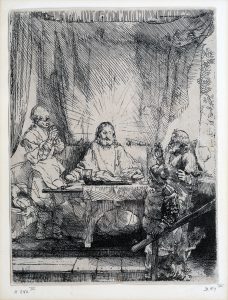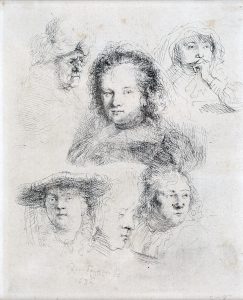
This year marks the 350th anniversary of the death of the Dutch master, Rembrandt van Rijn (1606-1669).
An artist of towering reputation, by the 1630s Rembrandt had become a highly respected artist. His fame and reputation as a painter ensured that his prints were seen as originals and not mere reproductions. In the 1630s and 1640s Rembrandt’s Amsterdam studio was very important attracting the attention and influencing a generation of artists.
Rembrandt achieved fame and success as a young man but would narrowly avoid bankruptcy in 1656 by an arrangement with the court to sell his house and its contents. The inventory of the sale still survives and provides an important insight into his collection and its influences on his work. It records that he owned Italian pictures, engravings after Raphael and other Italian masters, and a book said to have been illustrated by Mantegna.
Take for example Rembrandt van Rijn’s wonderful study of the story of the Supper at Emmaus from St Luke’s Gospel illustrated here. He exploits the creative process of printing to great effect. Drawing on the influence of the Italian artist Caravaggio Rembrandt employs the effects of chiaroscuro – strongly contrasted light and shadow affecting not only the composition but also the sense of volume.
It is a good inky impression. This is the fourth posthumous state indicating that it was pulled from the plate which Rembrandt himself had engraved in 1654 either at the end of his life or within a few years of his death. The composition and use of light is remarkable focusing our attention on the risen Jesus Christ as he reveals who he is to the two disciples who have unknowingly accompanied him on the road to Emmaus. As he breaks bread the story is united with the Last Supper and his Passion. Jesus’ expression as he looks on his follower is filled with empathy and tenderness. And in the shadows there is that marvellous dog.
Contemporary collectors of his prints afforded Rembrandt a freedom of expression which was sometimes lacking amongst the patrons of his paintings.
Etching allowed him to explore his deepening feelings for humanity which is ariculated with a freedom, insight and intimacy beyond the formal conventional portraiture of his time.

A good example of this is the etching, Studies of the Head of Saskia and others, from 1636. The love and tenderness with which he depicts her is readily apparent. Saskia, nee van Ulyenburgh, was the love of his life. Rembrandt’s art dealer, Hendrick van Uylenburgh, was Saskia’s cousin. Rembrandt was living and working with Hendrick and the couple met there in 1633 and were married soon after in 1634. Saskia died giving birth to their son, Titus, in 1642. Rembrandt was devastated.
Today Rembrandt’s works printed during his lifetime fetch thousands of pounds at auction. In contrast, despite his brilliance, Rembrandt died a pauper and was buried in an unmarked grave.
Toovey’s Director and specialist, Nicholas Toovey, is preparing his next curated auction of prints which will be held on 20th February 2019. He is always delighted to share his passion for prints with others and offer advice. He can be contacted on 01903 891955.
By Rupert Toovey, a senior director of Toovey’s, the leading fine art auction house in West Sussex, based on the A24 at Washington. Originally published in the West Sussex Gazette.